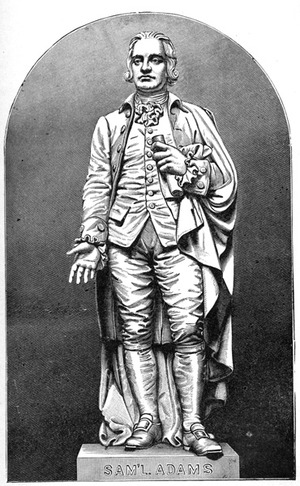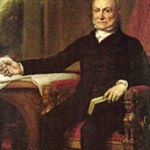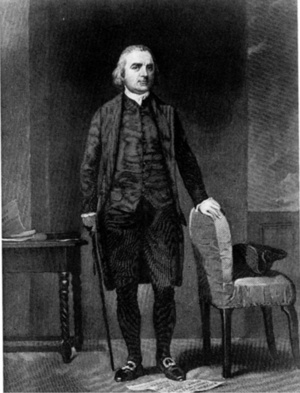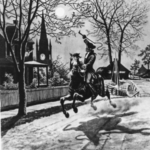In a previous article, I wrote about the history of the beautiful Neoclassical architecture, now known as the National Statuary Hall. It was built to be the home of the House of Representatives and served that function for many years.When a new hall was made for them in the Capitol, the Old Hall was converted into an art gallery featuring statues chosen by each of the United States to showcase their individual favorite local heroes.
Samuel Adams ( 1722 – 1803 ) was born in Boston, Massachusetts to a well off family who were active in politics and in the Puritan Church. His father, known as Deacon Adams, was a Justice of the Peace and a member of the Boston Caucus faction of the local town meetings. Deacon was a member of the Massachusetts House of Representatives and a founding member of the Whig Party, who were the opponents of the British Loyalists.
Young Samuel was well educated and knew Latin before he entered Harvard College at the tender age of 14. After graduation, four years later, he rejoined his father who loaned him money to start a business. After the money was pilfered away, his dad brought Sam into the family malt house. Samuel is often credited with being a beer brewer, but actually he was a producer of malt which is a vital ingredient. Deacon Adams then ran the families fortunes aground by participating in a banking enterprise which used mortgages on his property as collateral. Political rivals in the Loyalist cause had British Parliament dissolve the bank, making Deacon the target of lawsuits and liabilities until the day he died. Samuel was called on to defend his family estate against seizure, creating a life long grudge against the arbitrary use of power by the British.
When Samuel was 26, he started a newspaper called the Independent Advertiser that was a vehicle for his essays on politics and Puritan values. He drifted through several occupations and even tried his hand as a tax collector, which he showed no enthusiasm for. His efforts backfired when he became liable for uncollected taxes from his friends. He found his true calling as a revolutionary propagandist after the Seven Years War ended with a massive debt for the British Empire. Their scheme was planned to pay off the debts by taxing the colonies which was a mistake leading to fateful events.
In 1764, the British imposed a Sugar Tax that soon stirred up trouble. Samuel Adams wrote a document for the Boston Town Meeting that introduced his famous ” No taxation without representation” phrase which would become a rally cry. Adams’ rebellious content was republished in newspapers and pamphlets throughout the colonies. In 1765, the British followed up with the Stamp Act which put a tax on all sorts of printed materials.
Adams organized boycotts on British products and continued to write in support of colonist rights. British officials and tax collectors were harassed, tarred and feathered . Their homes and offices were wrecked and burned while their effigies were hung from trees and lamp posts.
The British appointed Governor Francis Bernard blamed Samuel Adams for the chaos, claiming that his propaganda incited the mob to violence and treason. In public, Samuel officially supported non-violent resistance to the parliamentary taxation, such as petitions, boycotts, and public demonstrations. His editorials helped get the Stamp Act repealed, but in 1767 the British tried again to tax the colonies through the Townshend Acts.which pushed a minimum tax on a variety of British products. This was a sneaky way to establish a foothold on which larger taxes could be expanded. Samuel Adams was having none of it and soon drafted a response known as the Massachusetts Circular Letter which was sent around to the other colonies.
There was an escalation in hard feelings when the British warship HMS Romney was sent to Boston Harbor to establish a stronger British military presence. After the troops tried to confiscate a merchant ship belonging to John Hancock, there was a riot that came close to extreme violence, short of death The HMS Romney conveyed custom officials and concerned Loyalists to safety at Fort Castle William on a harbor island. Soon , four regiments of the British Army arrived to occupy Boston. An underground newspaper called the “Journal of Occurrences” was circulated depicting the brutality and rape by undisciplined British soldiers. True or not, the unsigned chronicles fanned the flames of resentment among the colonists. A confrontation known as the “Boston Massacre” led to the shooting deaths of five unarmed civilians . Once again, Samuel Adams was a focus for the blame from Loyalists. In a strategic move, he persuaded his cousin, John Adams, to be the defense lawyer to represent the shooters. This would demonstrate that the town of Boston was a civilized society and not an unruly mob. After John Adams did such an amazing job in the defense, Samuel was outraged that the soldiers were not convicted of murder.
Here’s a link to my article about John Adams and the Boston Massacre.
After the sensational trial and the repeal of the Townshend Acts , the temperature cooled on frictions between the colonies and the Empire. Samuel Adams and Massachusetts went back to commerce and politics.
By 1772, Samuel Adams had helped to organize the ” Committees of Correspondence” which was a private postal service between the colonies. Adams kept the towns up to date on British activities and shared Sam Adams opinions, which opposed encroachments upon the colonist rights. In 1773, the British tried once again to tax the colonies with the Tea Act. When the British ship, Dartmouth, arrived in Boston Harbor, Adams wrote a circular flyer to organize a protest rally. Several other tea ships arrived as the protest number rose to 7000 concerned colonists. Samuel was visible working hard to keep the meeting organized so it was unknown if he joined a group of men who broke away and disguised themselves as Mohawk Indians. He might or might not have been at the Boston Tea Party when 342 chests of premium quality tea were dumped into the seawater. We do know that later, he defended the action as a principled protest by colonists in protection of their rights.
From this point , the colonies and the British Empire were on the path to war. General Thomas Gage was the commander of all the British military forces in North America. Samuel Adams and John Hancock were at the top of his list to be arrested for political agitation. After timely warnings from the ride of Paul Revere, Adams and Hancock escaped while the opening shots of the American Revolutionary War were fired at Lexington and Concord.
That story has filled volumes of weighty books in libraries too numerous to be counted easily. In summary, Samuel Adams played an important part in the creation of the new country. He was perhaps less public and less famous than the other Founding Fathers, but he was credited by Thomas Jefferson as an essential participant. Samuel was on hand for the signing of the Declaration of Independence and the Articles of Confederation. He was an advocate of the Constitution and the Bill of Rights.
Here is a link to my article about the Declaration of Independence and the evolution of the American Flag.
The historical evaluation of Samuel Adams has varied over the years, depending on the direction of the prevailing political winds. Massachusetts has expressed the loyalty of the state by choosing him to represent them in the National Statuary Hall.





